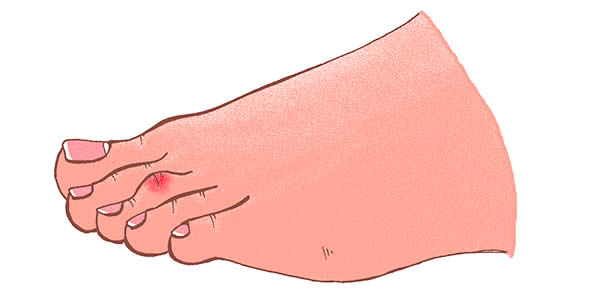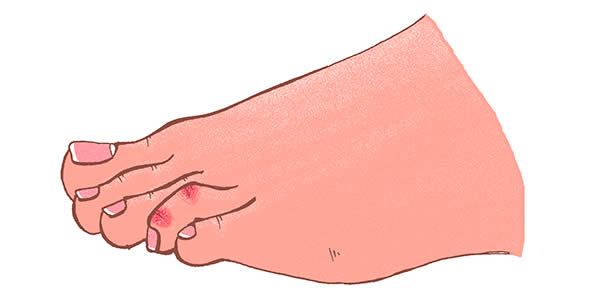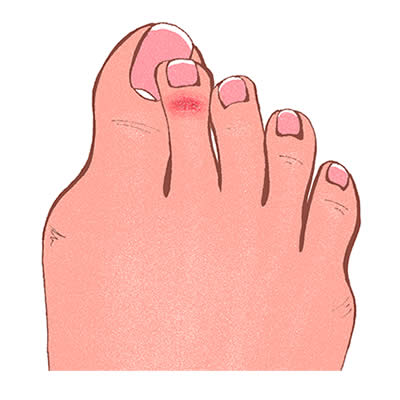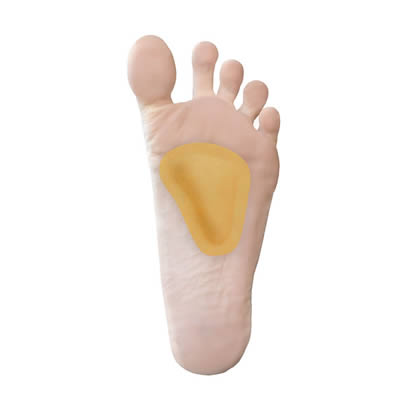Toes may look small, but they play a big role in your overall strength and posture.
Strong, aligned toes create a sturdy foundation for knees, hips and back. They also play an important sensory role for balance.Sometimes, however, toes become weak and bend out of shape, which can lead to a multitude of foot health issues.
So why do bent toes occur? And if you already have bent toes, what can you do to treat them? Keep reading to learn how to fix curled toes and other toe ailments!
Feet as Foundation
Construction on the Tower of Pisa began in 1174 AD. Even before it was completed, the tower started to tilt on its faulty foundation and immediately gained notoriety as a tourist curiosity.Fast forward to 1990... the Tower was in acute danger of collapsing and closed to the public until it could be repaired. This led to global teams of preeminent scientists and engineers working diligently for eleven years to develop a complex system of weights and soil removal. Ultimately, the project was a success and the tower was stabilized enough to guarantee its safety for the next several centuries (the Tower of Pisa could have been righted completely, but a four-meter incline was preserved to maintain its historical tourist popularity).

The notoriety that originated with the tower's faulty foundation came at a price: expensive engineering, restrictions and ongoing monitoring. The same goes for your feet.
Studies show that 36% of shoe wearing people over the age of 55 suffer from some form of bent toe deformity [source]. These can be bunions, hammer toes, claw goes, mallet toes and/or crossed toes.Even more people have corns and calluses that form where the bent toes rub against their shoes, or other painful nerve issues such as Morton’s neuroma. Bent toe deformities are progressive, and with time they can dimishish your foot foundation, cause pain in your knees and back and greatly affect your overall quality of life. If left untreated for too long then some serious engineering (i.e., surgery) may eventually be necessary.
The good news is that symptoms can often be spotted early and simple lifestyle changes can greatly reduce or even reverse the negative impact of damaged toes.
What Causes Bent Toes?
Bent toes usually develop slowly over decades, often first becoming noticeable to people in their late 20s and gradually worsening with time to more severe appearance and foot health issues.They are usually painful and if left untreated can lead to serious mobility restrictions for seniors.Podiatrists disagree on whether footwear is the only cause of bent toes or if there is a hereditary component that compounds with arthritis, but there is growing evidence that wearing confining and ill-fitting shoes is the primary aggravating factor.For example, women are much more likely to have issues with bent toes than men, which can be attributed to common women's shoe styles that feature high heels and heavily tapered toe boxes [source]. Furthermore, bent toes are rarely seen in children and are virtually nonexistent in cultures of people who live without shoes [source].

If your toes are held tightly together in the toe box of your shoes for prolonged hours everyday then they will slowly begin to cast the shape of that shoe over time.As time goes on, your toes will remain malformed even after shoes are removed. At that point, even flexing toes may become painful and difficult.
Symptoms
Besides the obvious visible bend or curvature, early symptoms of damage may be achy, swollen or stiff toes. Corns and calluses may be early indicators that your toes are not happy and in need of attention.Bent toes often correlate with knee and back pain as your body tries to shift pressure off the painful points to other muscles and bones in your feet and legs.Painful nerve issues such as Morton’s neuroma—a sharp burning pain in the ball of your foot—are also a sign of toe damage. Finally, if you find great relief in taking your shoes off at the end of the day then it is possible that you are on a path towards bent toes and other poor foot health issues down the road.
Types of Toe Issues
Bent toes can come in many forms. Here are some of the most common conditions.
CROOKED or BENT BIG TOE (a.k.a Bunions)

A big toe bending in at an angle toward the smaller toes is usually the first sign of trouble in feet.While the medical term for this condition is called hallux valgus, it is popularly known by its lay term: bunion. It may surprise you to learn that a bunion is not just the bump that results on the side of your foot, but rather the “bump + big toe bend” combination.The misalignment of the big toe causes it to turn inward towards the other toes, which leaves a bump of bone or tissue on the side of the foot where the big toe joint originates. If left untreated, calcium will begin to form over this protrusion, making the bump larger and more painful over time.
Unforunately, bunions have become so common in modern day western culture that an angled big toe pointing inward is often regarded as normal, so many people do not recognize it as a problem. It is also widely misconceived that bunions are simply hereditary, but new evidence suggests that is not the case [source].
CROOKED or BENT “LESSER” TOES (second, third, fourth orfifth toes)
There are many colorful layman’s terms for bent deformities of “lesser” toes, including hammer toes, claw toes and mallet toes. Problems with lesser toes are diagnosed not only by appearance, but also by the inability to flex the foot or wiggle these toes.
Hammertoes:

The middle joint of the toe bends downwards, which causes the toe to have a curved shape and not lie flat. Hammertoes are usually seen on second, third, and fourth toes.
Claw Toes:

The joint at the base of the toe bends upwards and other joints bend down. This causes toes to curl downward and dig into the soles of shoes. Claw toes can occur on any lesser toe.
Mallet Toes:

A toe bends down at the joint near the tip, closest to the toenail.Like hammertoe, it often happens in second, third, and fourth toes.
Crossover Toes:

Also called "Overlapping Toes," this occurs when a toe overrides an adjacent toe.This type of issue usually is a progression of the above issues left untreated and worsening over time and is most often seen with the second or fifth toe.
Treating Bent Toes
Healthy feet that are unimpaired by pointy shoes will be widest at the toes, with toes that are straight and strong. If your toes are heading in the wrong direction (no pun intended) then you can start working to fix your foundation immediately.In many cases, early detection and simple lifestyle changes will not only improve foot health, but possibly even reverse damage and restore feet to their original healthy shape. Remember to always consult your physician before beginning any exercise program to determine if it is right for you.
Just as it can take years to create problem with bunions or bent toes, it will likely take time to alleviate or reverse this damage. Reversal of moderate issues of malfomed toes may take 1-8 years, depending on your approach.If you wait until your problems are more severe then it will likely take longer, and extreme cases may even require surgery.
And please remember: we're shoemakers, not doctors. The tips below are taken from articles by medical professionals, but our staff is not qualified to prescribe treatment or answer medical questions, and we make no guarantees about results. Any exercises or treatment you undertake is done at your own risk.
1. Seek Out Healthy Shoes
The first step on the road to recovery is to start transitioning to shoes that allow toes and feet to move naturally [source]. For starters, look for shoes with wide toe boxes. In addition to having enough room for toes to spread out, the ideal shoe will also be zero-drop, meaning the heel is not thicker or higher than the front of the shoe. Also, shoes with toe springs, or toe areas that point upward, can also exascerbate issues with bent toes, so look for shoes that allow your toes to lay flat or level with the rest of your foot while you are standing still.
For more info, check out our guide of features to look for in healthy shoes:
Healthy footwear that allows natural foot function may be an important step you can take towards your future foot health, but don't rush! It is important to make this change gradually to prevent injury while your feet adjust to new shoes. After all, you will be using muscles and tendons in new ways, and likely stimulate weak muscles in your feet. You need to strengthen your feet slowly and carefully to avoid creating any additional damage. Think if it as when someone starts a running program—if you run a marathon your first day instead of gradually building up strength then you're asking for an injury.
Wide and flexible toe boxes are necessary for healthy foot restoration, as found in two of our favorite shoe styles: the Primal Sawyer and the Primal RunAmoc. If you cannot part with all your heels and fancy pointy shoes, at least try to limit wearing them only for special occasions and only for a few hours at a time.
2. Develop Foot-Strengthening Habits
After changing your footwear, there are a few healthy habits that will also help reverse the damage of bent toes:
- Spend a little time barefoot each day.
- Avoid tight socks or tight stockings.
- Massaging your feet to speed the dissolution of calluses and corns. In addition to hand massages there are quite a few over-the-counter foot massage tools, such as spikey balls that you roll under your foot.
- Try foot-strengthening exercises. One popular and cheap technique is to lay a towel on the floor and try picking it up with your toes—an easy exercise to do while watching TV!
- Consider consulting with a physical therapist for advice on foot strengthening exercises and stretches to help restore strength and improve your foundation.

There are also scores of helpful books and videos online available to give you more healthy tips for stretching and strengthening your toes. One of our favorites is the book Whole Body Barefoot: Transitioning Well to Minimal Footwear by renowned biomechanist Katy Bowman. Katy and her certified instructors also teach hands-on workshops across the country that often focus on restoring foot health for a strong foundation. For more info, visit her Nutritious Movement website.
3. Try Toe Spacers and/or Metatarsal Pads
Toe spacers can be a very effective tool to speed up recovery of damaged toes, but like minimalist shoes they should be introduced gradually.
Our favorite toe spacers are silicone Correct Toes, invented and tested by Dr. Ray McClanahan DPM. He was astounded that so many podiatrists immediately prescribed surgery for foot problems that he realized could be treated naturally, so he created Correct Toes for that very purpose.

Why do we like Correct Toes so much? Because they have many advantages to other toe spacers on the market:
- Dr. McClanahan designed Correct Toes using his extensive knowlege of foot anatamy. They have been thoroughly tested in medical trials for optimal comfort and effectiveness. Most knock-off brands cannot make this claim, and small differences in the design of toe spacers can have a painful or otherwise detrimental impact on your feet.
- Unlike most other toe spacers, Correct Toes are easily adjustable. In addition to being available in several sizes suitable for all kinds of feet, they can also be shimmed or trimmed to accommodate special needs. The instructions that come with Correct Toes provide information on how to make these adjustments.
- The flexible silicone design of Correct Toes are extremely versatile. While other toe spacers barely let you stand or walk while wearing them, Correct Toes can easily be worn during athletic activities, including hiking and running.
- Great customer service! Based in Portland, Oregon, the Correct Toes staff work closely with Dr. McClanahan and his clinic, and many of them are medical professionals themselves so they have encyclopedic knowledge regarding the natural treatment of foot problems. Check out the Correct Toes website for access to their vast knowledge base.
Similarly, metatarsal pads can further promote the restoration of natural foot function [source]. Conventional shoes with tapered toe boxes and raised toe springs often result in the metatarsal arch (the arch under the ball of your foot) deforming by pushing outwads. Metatarsal pads can be placed in shoes so that they sit just below the ball of your foot, which will help the metatarsal arch gradually return to it's natural position.

Dr. McClanahan usually recommends metatarsal pads to his patients for use with Correct Toes, as the two work very well together to speed up the recovery process.
For many individuals, the steps above may be enough to reverse damage from bent toes, or at least prevent further damage and alleviate pain. We can attest at our shoemaking workshop that many of our customers were told they needed surgery to repair their toe issues, but found that switching to minimal shoes, wearing toe spacers and performing simple exercises were enough to resolve their problems.
If your bent toes are too severe, however, then more drastic treatment may be necessary. If you are in constant pain, if you are experiencing severe arthritis or if the deformation is serious, then we recommend seeking advice from a medical professional.
Invest in your future health by giving your body the best foundation possible.Take inventory of how strong and straight your toes are, of any bending toes, corns or calluses and begin steps towards righting your footing now. (Pun intended).
Thanks to our artistic Elf Molly for drawing the foot sketches in this post!
Related posts:
C.Elf.O Tricia
Trish has been an entrepreneur, marketer and maker ever since she crushed her first lemonade stand at age five. Growing up in rural Wisconsin, she spent many summers running barefoot with her sisters. These early memories later inspired her to build a brand which embraced the joy and freedom of childhood with the health and science of minimal footwear.
Trish relishes evolving the company to grow stronger and more competitive with each passing year. She is a frequent expert panelist for both e-commerce and entrepreneurship conferences. Trish enjoys spending time with her family, dogs and ducks on their property in Oregon and loves the proximity to both surf and snow. She has a background in Engineering Physics and an MBA from the University of Chicago.
